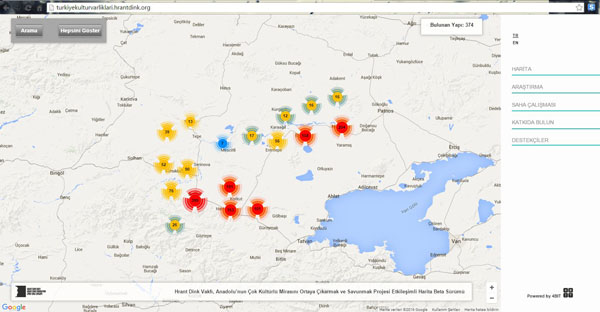Yok edilen uygarlığın kültür envanteri gün yüzüne çıktı

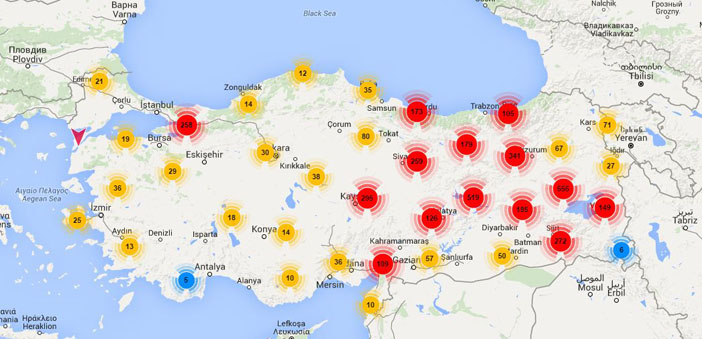
Envanter, yok edilen uygarlıkla birlikte neyi kaybettiğimizi anlamak için de benzersiz bir kaynak. Tek yapmanız gereken, turkiyekulturvarliklari.com adresine gitmek.
Hrant Dink Vakfı, ‘Anadolu Kültürel Mirası’ projesi çerçevesinde Rum, Ermeni, Süryani ve Yahudi toplumları tarafından inşa edilen kilise, sinagog, manastır, okul, hastane ve mezarlık gibi yapıların envanterini çıkarttı. Yaklaşık iki buçuk yıl boyunca yapılan çalışmalar sonucunda, yaklaşık 10 bin yapı ortaya çıkartıldı. Anadolu’nun geçmişinde, yüz yıllarca varlık göstermiş halkların, büyük çoğunluğu yok edilmiş olan kültürel mirasına dair ilk defa bu kadar kapsamlı bir envanter ortaya çıkartılmış oldu. Vakıf, interaktif bir haritayla, verileri herkesin kullanıma açtı.
Çalışma, 2014 yılının ilk aylarında başladı. Araştırmacılar, Nora Mildanoğlu, Zakarya Mildanoğlu, Mustafa Batman, Ezgi Deniz Berk, Merve Kurt, Vahakn Keşişyan, Tuna Başıbek, Aleksandros Kamburis, Şahika Karatepe, Zeynep Oğuz ve Norayr Olgar’dan oluşan ekip; çeşitli kaynaklar üzerinde araştırma yaptı. Anadolu’nun dört bir yanında hâlâ ayakta olanların yanı sıra, yıkılmış, yakılmış, korunamamış, depo ve veya ahır olarak kullanılmış, camiye çevrilmiş yapıların da listesi ortaya çıkartıldı. Projeye AB Türkiye Bakanlığı, Açık Toplum ve Chrest Vakfı’da destek oldu.
Proje koordinatörü Merve Kurt ve araştırmacılar, Tuna Başıbek, Zeynep Oğuz, Aleksandros Kamburis ve Vahakn Keşişyan, çalışmanın detaylarını anlattı.
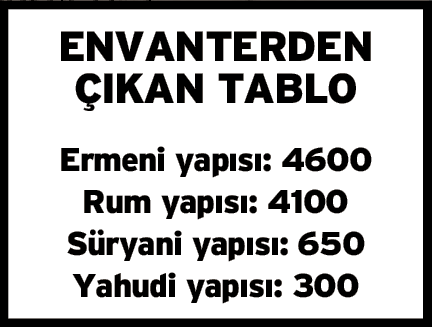
Böyle bir çalışma daha önce yapılmadı
Proje koordinatörü Merve Kurt, çalışanın Anadolu’daki gayrimüslimlerin kültürel mirasının ortaya çıkartıldığı ilk proje olduğuna dikkat çekerek çalışmaya dair şu bilgileri verdi.
“Birinci ve ikinci kaynaklar tarandı. İlk sene sadece Ermeni kültürüne odaklanılarak çalışma yapıldı. İkinci sene ise Rum, Yahudi ve Süryani mirası üzerine çalışma yapıldı. En fazla yararlandığımız, kilise defterleri. Başbakanlık Osmanlı Arşivi’nde çalışma yaptık. Elimize geçen bütün kaynaklarda, nerede bir kilise veya okuldan bahsediliyorsa onları envantere döktük”
Çalışmada karşılaşılan zorluklara dikkat çeken Kurt, “Rum kaynakları için Yunanistan’da Küçük Asya Kültür Araştırmaları Merkezi, Süryani kaynakları için İsveç’e gidildi. Oradan çok sayıda veri elde edildi. En çok zorlandığımız konulardan biri yer adları. Biz, bugünkü il sınırları üzerinde çalıştık. Eski arşivler il sınırları bu şekilde olmadığı için onunla ilgili ayrı bir çalışma yaptık. Eski adları yeni adlarla karşılaştırmak zor oldu.”
Veriler herkese açık
Kurt, bulunan verilerin, internet sitesinde oluşturulan bir harita aracılığıyla herkesin ulaşımına ve katkı sunmasına açık hale getirildiğinin altını çizdi.
“Bu harita Hrant Dink Vakfı’nın yaptığı çalışmanın görselleştirilmiş hali. Ermeni, Rum, Süryani ve Yahudi toplumlarına ait kamusal alanların, yani kilise, hastane, sinagog okul, manastır, yetimhane ve mezarlıkların harita üzerinde gösterildiği interaktif bir harita. Envantere ulaşmayı kolaylaştıran kullanıcı dostu bir çalışma. Fotoğraflar, tarihi bilgiler ve bu bilgilerin yer aldığı kaynaklar harita üzerinde gösteriliyor”
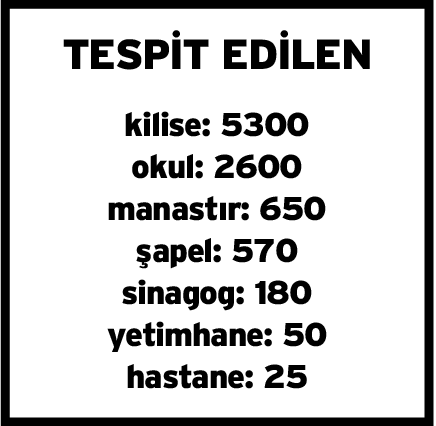
Korunması gereken çok yapı var
Bu projenin farkındalığın arttırılmasına katkı sağlayacak bir proje olduğunu ve korunması gereken yerlerin ne kadar fazla olduğunu ortaya koyduğunu belirten Kurt, “Bu yapılar tescillenmiş olsa dahi kırık dökük halde, hala definecilerin kazı çalışması yaptığı yerler. Her bölgede koruma kurulları var. Ama mesela Kayseri’de envanterlerinde 30 ya da 35 yapı görünüyor oysa bizdeki veri 130. Onların göz ardı ettiği yerler de var. Onlar için de aslında önemli bir veri.”
Proje devam edecek
Saha çalışmasının yapılması için projenin devam edeceğini belirten Kurt, bundan sonrası için şunları söyledi: “Elimizdeki verileri gidip sahada kontrol edeceğimiz bir çalışma yapılacak. Bir de daha farklı bir saha çalışması yapılacak. Üç bölge tespit edilecek. Bir okul, bir sokak ve bir kilise tespit edilip, oralara gidip sözlü tarih çalışması yapılacak. İnsanların hikayeleri kayıt altına alınacak. Bununla berber halk, oradaki yapıları nasıl görmek istediğine karar verecek ve ortaya çıkacak olan bu çalışmanın sonuçları da yetkililere sunulacak”
Kaynaklar
Araştırmacı Vahakn Keşişyan, envanter çalışması boyunca kullanılan kaynakları ve metotları anlattı.
“İlk aşamada temel kaynaklar belirlenerek envanter oluşturuldu. Raymond H. Kévorkian ve Paul B. Paboudjian’ın Ermeniler kitabı, Aram Khaçaduri Safradsyan’ın yayına hazırladığı ve Zakarya Mildanoğlu’nun Ermenice’den çevirdiği İstanbul Ermeni Patrikliği tarafından Türkiye Adliye ve Mezahib Nezareti’ne takdim edilen 1912-1913 tarihli Ermeni kilise ve manastır listeleri, Agos gazetesi arşivi ve Osman Köker’in Calumeno koleksiyonundan derlediği kartpostallar. Bunlar temel kaynaklar. Metodolojiye bu şekilde devam ettik. Her bir topluluk için ayrı temel kaynaklar seçildi. Bu kaynaklar üzerinden başlayarak, eksikleri de bulmak için başka kaynaklar da taramaya başladık. Diğer topluluklar için böyle kapsamlı ve temel kaynaklar bulmak oldukça zordu. Yahudiler için Naim Güleryüz’ün İstanbul Sinagogları ve Türkiye Sinagogları kitaplarını kullandık. Avram Galante ve Rıfat Bali’nin çalışmalarından yararlandık. İnci Türkoğlu’nun 2001’de Antik Çağ’dan Günümüze Türkiye’de Sinagog Mimarisi üzerine hazırladığı yüksek tezi de kaynaklarımız arasında. Rumlar için böyle ana bir kaynak bulamadık ama bölgelere dağılmış pek çok kaynak vardı. En büyük kaynakça Küçük Asya Araştırmaları Merkezi. Orada mübadele zamanında yerleşen Rumlarla sözlü tarih çalışmaları yapılmış. Büyük bir veri var. Orada çalışma yaptık. Zor bir çalışma, dijital yok, hepsinin okunması gerekiyordu. Süryaniler için Gabriel Akyüz’ün Mardin ve çevresindeki kilise ve manastırlarla ilgili kitabı, Gertrude Bell’in 1910’da ve Hans Hollerweger’in 1999’da Tur Abdin bölgesi yapıları üzerine yürüttükleri çalışmalar ile Elif Keser Kayaalp’in Kuzey Mezopotamya kilise mimarisi üzerine yazdığı doktora tezi temel kaynaklar olarak belirlendi. Çalışma yaptığımız dört topluluk dışında, Gürcü, Bulgar ve Levantenlere ait yapılar da bulundu. Ancak çalışma alanımızda olmadığı için onları envanterde gösteremiyoruz. Ama verileri elimizde.”
Envanter rakamları üzerine çalışma yaptıklarını ve beklenenin çok üzerinde yapı ortaya çıktığını belirten Keşişyan, “İkinci aşamaya başladığımızda Ermenilerin 4 bin civarında yapısı vardı. Rumların ise 2 bindi. Çalışmanın sonucunda Rumların yapıları 4 bine ulaşmış durumda. Süryanilerin 700’e yakın yapısı ortaya çıktı. Kayseri’ye başlarken 250 yapı vardı. Kayseri odaklı çalışmaya başlayınca, rakam 350’ye çıktı. Sahaya gidince 400’e ulaştık. Bir yere odaklı çalışma başlayınca rakamlar artıyor.”
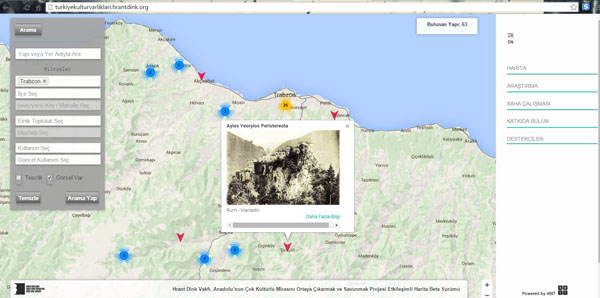
Tarihin bir dönemi kesintiye uğramış durumda
Projenin araştırmacılarından Aleksandros Kamburis, Rum yapıları üzerine yapılan araştırmayı anlattı:
“Üç tane kurum dahil oldu çalışmamıza. Patrikhane, Konsolosluk ve Atina’da Küçük Asya Araştırmaları Merkezi. Çoğu veriyi oradan bulabildik. En büyük sorun tarihsel bilginin ortadan kaybolması. Özellikle Türkçe dışındaki dillerde, İstanbul’da dahi Rum topluluklarının araştırmalarıyla ilgili Yunanca çok şey bulunması mümkün değil. Bir kısmını Rumlar gidince kendi arşivlerini ve kendi kayıtlarını beraber aldılar. Bunları şimdi Küçük Asya Araştırmaları Merkezi’nde bulabiliyoruz. Azınlıkların ortak bir bilgi merkezi veya hafıza merkezi yok. Rum Edebiyat Derneği’nden alınmış bir kütüphane var. Orada çok ciddi bir araştırma vardı. Bu kütüphane derneğin elinden alındı ve kayboldu. Çok ciddi bir tarihsel bilgiyi kaybettik. Çalışmalarda 1920’lere kadar gerçekçi bilgilere ulaşabiliyoruz. Sonrasına dair bilgimiz yok. Kiliselerin ve kamu yapıların takipleri yapılamıyor. İnsanlar tekrar geri döndüklerinde kiliselerin olmadığını görüyor ve bizler bu aradaki döneme dair bilgiyi kaybetmiş oluyoruz.”
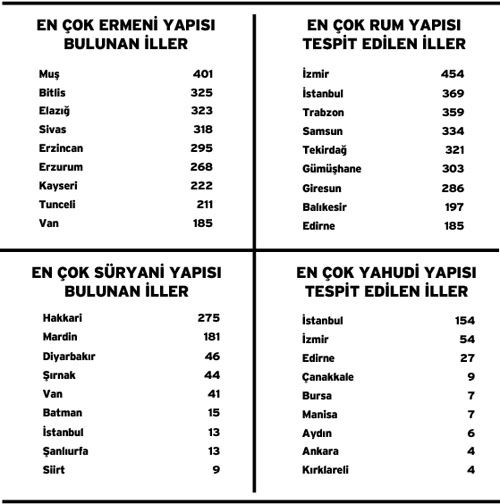
En önemli sorun isim değişiklikleri
Başbakanlık Osmanlı Arşivleri’nde yapılan çalışmanın detaylarını proje araştırmacılarından Tuna Başıbek aktardı:
“Osmanlı Arşivlerinde iki temel kaynak var. Biri bir defter tam tarihi bilinmiyor. Sanırım 19. yüzyıl sonu ya da 20. yüzyıl başında tutulmuş. Çok sağlam ve iyi veriler var. Son derece teknokratik anlamda her şey sıra dizilmiş. Diğeri kilise defterleri. 10 defter var ve yedisi arşivde. Yereldeki din temsilcileri tarafından merkeze yazılmış. Yapı, yeri ve yeniden inşası yazıyor. Biraz daha detaylı bilgiler var. En önemli sorunlardan biri yer isimleri. Muhtemelen defteri tutan memur, yerin ismini ya bilmiyor ya da yanlış yazıyor ya da ismi veya sınırları değişmiş olabiliyor. Kiliseleri, kiliselerin yerlerini, hangi cemaate ait olduğunu, kimin arazisi üzerine inşa edildiğini bilebiliyoruz. Kayıtlar yeniden inşa şeklinde tutulmuş. Nerdeyse bütün kiliseler, yeniden inşa tarihiyle açıklanıyor. Bu yüzden ilk yapım tarihlerini bilemiyoruz.”
Kendi içinde çeşitliliği var
Araştırmacılardan Zeynep Oğuz, Yahudi kamusal yapıları üzerine yaptıkları çalışmanın metodolojisini anlattı:
“Bir dil sorunumuz oldu. O yüzden ikincil kaynaklardan yararlanıldı ama Türkiye’ye dair bilgiler için Türkçe kaynaklar daha yararlı olabiliyor. Naim Güleryüz’ün kitapları var. Onun içinde var olmayan yapılara dair o kitaplarda referanslar var. Anladık ki Naim Güleryüz’ün kitabı dışında kapsamlı bir çalışma yok. Aslında İngilizce akademik çalışmalar yapanlar var. Agos, Bianet gibi basın yayın organları sayesinde, satışa çıkan evler, sinagoglar, güncel haberler üzerinde öğrendiğimiz bilgilerin bu kaynaklarda olmadığını fark ediyoruz. Geriye dönük kaynaklar, yok denecek kadar az. Bilgilerde bir süreklilik olduğunu söyleyemeyiz. Benim şahsi olarak beklemediğim İskenderun gibi Hatay gibi yerlerde halen açık sinagoglar var. Yahudi kültürünün kendisinin de bir çeşitliği var. Biz daha çok yakın zaman Aşkenaz ve Sefarad yapılarını biliyoruz ama daha eski yapılar da var Türkiye’de.”
Ermeni yapılarının kaynakları
Projenin ilk aşamasında Ermeni yapıları üzerine çalışma yapıldı. Raymond H. Kévorkian ve Paul B. Paboudjian’ın Ermeniler kitabı, Aram Khaçaduri Safradsyan’ın yayına hazırladığı ve Zakarya Mildanoğlu’nun Ermeniceden çevirdiği İstanbul Ermeni Patrikliği tarafından Türkiye Adliye ve Mezahib Nezareti’ne takdim edilen 1912-1913 tarihli Ermeni kilise ve manastır listeleri, Agos gazetesi arşivi ve Osman Köker’in Calumeno koleksiyonundan derlediği kartpostallar temel kaynaklar oldu. Ermeni yapılarının en çok bulunduğu şehir olan Muş’ta 401 yapı tespit edildi.
Nasıl dahil olunacak?
Keşişyan, , interaktif harita aracılığıyla çalışmaya isteyen herkesin kolaylıkla dahil olunabileceğini söyledi: “Öncelikle, bu devam etmekte olan, önerilere ve katkılara açık bir proje. Sitede her yapı için, ‘fotoğraf ekleme’, ‘bilgi ekleme’ ve ‘bilgi değiştirme’ seçenekleri var. İsteyen herkes, elindeki kaynakları, fotoğrafları ve bilgileri gönderebilecek. ‘Yeni yapı ekle’ seçeneğiyle, listede yer almayan bir yapıyla ilgili olarak da bilgi ve fotoğraf gönderilebiliyor. Bunların hepsi önümüze öneri olarak gelecek ve tamamını veri olarak saklayacağız.”

